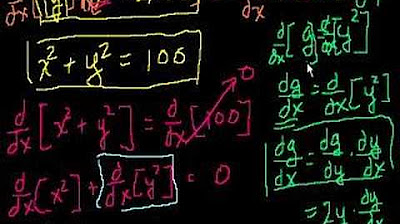Derivative of absolute value function
TLDRThis educational video script guides viewers through the process of differentiating the function y equals the absolute value of 2x minus 3. It begins by explaining why the simple differentiation of y=2x to get a derivative of 2 is not applicable here due to the absolute value function. The script then introduces the concept that the absolute value of x can be rewritten as the square root of x squared, which is a key insight for differentiation. Using the chain rule, the video demonstrates how to differentiate y=|x|, resulting in dy/dx = x/|x|. Finally, it applies a similar method to differentiate y=|2x-3|, introducing a substitution with u=2x-3 and using the chain rule to find dy/dx = (2x-3)/|2x-3|. The script emphasizes the importance of understanding the underlying concepts and encourages continuous learning.
Takeaways
- 📚 The script discusses the differentiation of the function y = |2x - 3|, emphasizing that it's not as straightforward as differentiating a simple polynomial.
- 🔍 It clarifies that the derivative of an absolute value function isn't simply 1 or -1, as there are two directions (positive and negative) to consider.
- 📐 The video introduces an alternative representation of the absolute value function, suggesting that |x| can be rewritten as √(x^2), which is a key insight for differentiation.
- 👨🏫 The presenter advocates for teaching the square root representation of absolute value from the beginning, as it simplifies the process of finding derivatives.
- 🧩 The differentiation of y = |x| is demonstrated using the chain rule, showing that the derivative is x / |x|, not a constant as one might initially assume.
- 🔄 The process involves recognizing that |x| can be expressed as x^2 raised to the power of 1/2, and then applying the chain rule to differentiate it.
- 📉 The script uses the example of differentiating y = |2x - 3| by introducing a substitution, letting u = 2x - 3, to simplify the differentiation process.
- 🔑 The chain rule is applied again to find the derivative of y = |u|, resulting in the expression (2u) / |u|, where u is the substituted variable.
- 📝 The final derivative of y = |2x - 3| is given as (2(2x - 3)) / |2x - 3|, which is a product of the derivative of the inside function and the inside function itself, divided by the absolute value of the inside function.
- 🚀 The video concludes with an encouragement to continue learning, highlighting that learning is an ongoing process essential to living.
Q & A
What is the main topic of the video?
-The main topic of the video is to demonstrate the process of differentiating the function y = |2x - 3|, including the concept of absolute value and its derivative.
Why is the differentiation of y = |2x - 3| not straightforward?
-The differentiation of y = |2x - 3| is not straightforward because the absolute value function can have two possible expressions, one for x ≥ 0 and another for x < 0, which means the derivative cannot be a single constant value like in simpler functions.
What is the initial misconception the video aims to correct regarding the absolute value function?
-The initial misconception the video aims to correct is that the derivative of the absolute value function is not simply 1 or -1, but rather a more complex expression that depends on the variable inside the absolute value.
How does the video suggest rewriting the absolute value of x?
-The video suggests rewriting the absolute value of x as the square root of x squared, which is a more mathematically rigorous representation of the absolute value function.
What mathematical rule is used to differentiate the absolute value of x?
-The video uses the chain rule to differentiate the absolute value of x, by expressing it as x squared raised to the power of one half.
What is the derivative of y = |x| according to the video?
-According to the video, the derivative of y = |x| is x divided by the absolute value of x, which can be written as x / |x|.
What substitution is made to simplify the differentiation of y = |2x - 3|?
-The substitution made to simplify the differentiation of y = |2x - 3| is letting u = 2x - 3, which allows the use of the chain rule to find the derivative.
What is the derivative of u with respect to x in the context of the video?
-In the context of the video, the derivative of u with respect to x, where u = 2x - 3, is 2.
How is the chain rule applied to find the derivative of y = |2x - 3|?
-The chain rule is applied by multiplying the derivative of the outer function (dy/du, which is u / |u|) by the derivative of the inner function (du/dx, which is 2).
What is the final expression for the derivative of y = |2x - 3| presented in the video?
-The final expression for the derivative of y = |2x - 3| presented in the video is 2(2x - 3) divided by the absolute value of (2x - 3).
Outlines
📚 Introduction to Differentiating Absolute Value Functions
This paragraph introduces the concept of differentiating absolute value functions, starting with a simple example of 'y = |2x - 3|'. The speaker emphasizes that the derivative of an absolute value function is not straightforward and cannot be answered with a single value. The paragraph sets the stage for a deeper exploration into the differentiation process, hinting at the complexity involved due to the nature of the absolute value function, which always results in a 'V' shape. The speaker also suggests a common misconception about the derivative of absolute value functions and hints at a more nuanced understanding that will be developed throughout the video.
🔍 Derivative of Absolute Value of x and Chain Rule Application
The speaker begins by differentiating the simpler case of 'y = |x|', explaining that the result is not a constant value but rather a function of x. They introduce the concept that the absolute value of x can be rewritten as the square root of x squared, which is a crucial insight for understanding the differentiation process. The chain rule is then applied to differentiate 'y = |x|', resulting in the derivative 'dy/dx = x / |x|'. This part of the script serves as a foundation for understanding how to differentiate more complex absolute value functions, such as 'y = |2x - 3|', which will be tackled in the subsequent paragraph.
📘 Differentiating Absolute Value of 2x - 3 Using U-Substitution
Building upon the previous discussion, the speaker now addresses the differentiation of 'y = |2x - 3|'. They introduce a U-substitution technique where U is set to '2x - 3', simplifying the problem to differentiating 'y = |U|'. The derivative of U with respect to x (du/dx) is identified as 2. The chain rule is then applied again, leading to the final derivative 'dy/dx = (2 * (2x - 3)) / |2x - 3|'. This step-by-step process illustrates the application of the chain rule and U-substitution in the context of absolute value functions, providing a clear path to the solution and reinforcing the learning from the earlier examples.
Mindmap
Keywords
💡Differentiation
💡Absolute Value
💡Derivative
💡Chain Rule
💡Square Root
💡U-Substitution
💡Function
💡Composite Functions
💡Square Root Function
💡Learning
Highlights
Differentiating the absolute value function requires understanding its behavior differently from simple derivatives.
The derivative of a simple expression like y=2x would be 2, but the absolute value changes this.
The absolute value function is always non-negative, which complicates its derivative.
The absolute value of x can be rewritten as the square root of x squared.
Differentiating the absolute value of x is not straightforward and involves the chain rule.
The chain rule is applied to differentiate y = |x| by considering it as (x^2)^(1/2).
The derivative of y = |x| is x divided by the absolute value of x.
Differentiating y = |2x - 3| involves a U-substitution with U = 2x - 3.
The derivative of U = 2x - 3 with respect to x is 2.
The chain rule is used again to find the derivative of y = |U| with respect to x.
The derivative of y = |U| with respect to x is 2U/|U| where U = 2x - 3.
The final derivative of y = |2x - 3| is (2(2x - 3))/(|2x - 3|).
Differentiating absolute value functions requires understanding their piecewise nature.
The process of differentiating absolute value functions is a good example of applying the chain rule and understanding piecewise functions.
Learning to differentiate absolute value functions is a key skill in calculus.
Transcripts
Browse More Related Video

Implicit Differentiation

Implicit Differentiation Method

Implicit Differentiation for Calculus - More Examples, #1

Average Value of a Function

Finding particular linear solution to differential equation | Khan Academy

Absolute Maximum and Minimum Values - Finding absolute MAX & MIN of Functions - Calculus
5.0 / 5 (0 votes)
Thanks for rating: